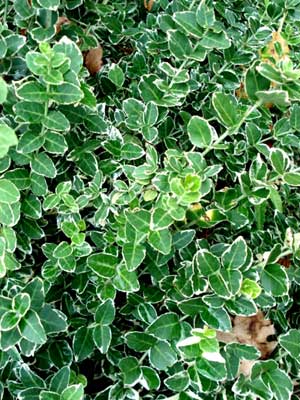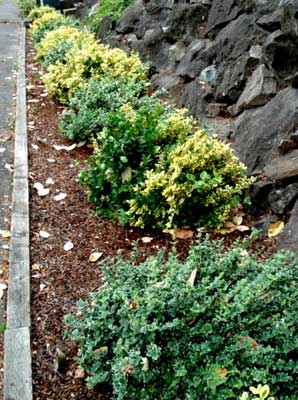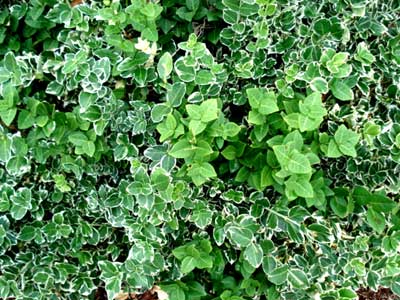
'Silver Queen'
Wintercreeper
"There is a little plant called reverence in the corner of my soul's garden."
-Oliver Wendell Holmes
(1809-1894)
"Methinks my own soul must be a bright invisible green."
-Henry David Thoreau
(1817-1862)
Wintercreeper as a species is native to Korea, Japan, & China, with the variant for radicans native to Japan. Its natural wild form can be harmfully invasive. Sundry variegated cultivars, however, are restrained to extreme, taking years to establish a good root system & thereafter still slowly spreading.(1809-1894)
(1817-1862)
The most commonly offered white or silver variegated forms in the marketplace are Euonymus fortunei var radicans 'Silver Queen' & 'Emerald Gaeity,' the latter generally smaller & more "creeping" than the former, but otherwise identical for leaf color.
 The shrub is upright in the center, fountaining at an angle midway down the mound, & straight outward horizontal to the ground around the bottom. It does about equally well in full sun, or partial shade.
The shrub is upright in the center, fountaining at an angle midway down the mound, & straight outward horizontal to the ground around the bottom. It does about equally well in full sun, or partial shade.Early summer flowers are for all intent & purposes invisible & 'Silver Queen' is grown exclusively for the foliage, which is a shiny dark green with cream-colored to silver-white edging.
An occasional limb of 'Silver Queen' reverts to green (as can be seen in the third photo) but is easily clipped out & the variegation is generally very stable. The vining qualities of the natural species is largely bred out of it, as it forms an evergreen shrub three feet tall by three or four feet wide, after several years.
I'm not a huge fan of wintercreeper so am satisfied to watch it growing in a neighbor's yards. For years I've watched a failed "hedge" of 'Silver Queen' planted in a straight row alternatingly with 'Emerald 'n' Gold.' This is down from our house one block away, & Daigoro has peed on those wintercreepers hundreds of times.
 They were planted a decade ago. The homeowner imagined them spreading into a hedgeable, solid mat of evergreen variegation. After five years they were still just little humpy messes spaced too far apart.
They were planted a decade ago. The homeowner imagined them spreading into a hedgeable, solid mat of evergreen variegation. After five years they were still just little humpy messes spaced too far apart.But after a decade, slow though it was, this row of shrubs had become substantial, & I rather like them now.
They're still nowhere near a groundcover or a hedge & never will be, so if it were my sidewalk garden, I'd want to plant other things around the wintercreepers, something equally hardy like a dwarf plumbago to get some blue flowers & a fuller groundcover. But the homeowner prefers beauty bark between the shrubs.
The positives for this plant include the strength of its evergreen presence all winter long, the colorfulness of those leaves, & the fact that it needs very little water or attention.
Even its ultra-slow growth rate can be a plus if it's needed for a finite location without constant pruning. But if one wishes it would grow a little more rapidly, a more regular watering schedule, with a monthly liquid fertilizing, as well as a humusy soil, will speed it up a bit.